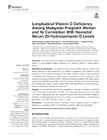Longitudinal vitamin D deficiency among Malaysian pregnant women and its correlation with neonatal serum 25-hydroxyvitamin D levels

Abstract
Objective: This study aimed to investigate the longitudinal relationship between maternal vitamin D concentrations during pregnancy and neonatal vitamin D concentrations at birth.
Materials and Methods: A prospective cohort of 236 healthy pregnant women from various ethnicity in early pregnancy (≤20 weeks of pregnancy) was followed at late pregnancy (28–40 weeks of pregnancy) and birth. Maternal serum 25-hydroxyvitamin D (25(OH)D) was assessed at early pregnancy (baseline) and late pregnancy, while neonatal cord serum 25(OH)D at birth. General estimating equations (GEE) were used to analyze the longitudinal association of maternal serum 25(OH)D levels during pregnancy and neonatal cord serum 25(OH)D levels at birth with adjusting for the time exposure, maternal weight gain, ethnicity, and skin type.
Results: The results showed that the prevalence of vitamin D deficiency (25(OH)D <50 nmol/L) was at 89.9, 92.2, and 96.1% in early, late pregnancy and in neonatal cord serum, respectively. The GEE analysis showed a trend that longitudinal vitamin D deficiency during pregnancy leads to lower vitamin D concentrations in neonatal cord blood (RR = 1.17; 95% CI (1.05–1.36); p = 0.04).
Conclusion: Longitudinal vitamin D deficiency during pregnancy leads to vitamin D deficiency in neonates at birth. A further trial is needed to affirm this association.
Collections
Date
2021-06-29Author
Basha, Muzaitul Akma Mustapa Kamal
Majid, Hazreen Abdul
Razali, Nuguelis
Rashed, Aswir Abd
Muhammad, Hussin
Yahya, Abqariyah